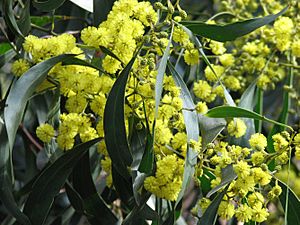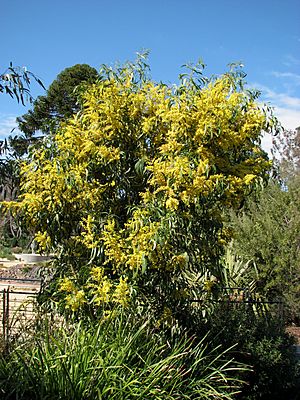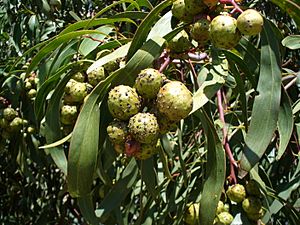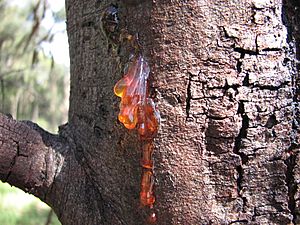Golden Wattle facts for kids
The golden wattle (Acacia pycnantha) is a beautiful tree from the pea family, Fabaceae. It is native to southeastern Australia. This tree can grow up to 8 meters (about 26 feet) tall. Instead of regular leaves, it has flattened leaf stalks called phyllodes. These phyllodes are shaped like a sickle and are usually between 9 and 15 cm (3.5 to 6 inches) long.
In late winter and spring, the golden wattle bursts with many sweet-smelling, bright golden flowers. After the flowers, long seed pods grow. Birds like honeyeaters and thornbills help the plant make seeds. They visit special spots on the phyllodes that produce a sweet liquid (nectar). As they feed, they brush against the flowers and carry pollen from one plant to another.
The golden wattle often grows under taller eucalyptus trees. You can find it in southern New South Wales, the Australian Capital Territory, Victoria, and southeastern South Australia.
The explorer Thomas Mitchell first collected a sample of this plant. Based on his sample, George Bentham officially described the species in 1842. The golden wattle's bark has more tannin than any other wattle species. Tannin is a substance used in leather making. Because of this, the golden wattle is grown on farms to produce tannin.
People also love to grow the golden wattle in gardens because it's so pretty and its flowers are great for cutting. However, it has become a weed in some parts of the world, like South Africa, and even in other parts of Australia, such as Western Australia and Tasmania. In 1988, Acacia pycnantha became the official floral emblem of Australia. You can even see it on Australian postage stamps!
Contents
What the Golden Wattle Looks Like
The golden wattle usually grows as a small tree, between 3 and 8 meters (10 to 26 feet) tall. Some have been reported to grow up to 12 meters (39 feet) in Morocco. The bark is usually dark brown to grey. On younger trees, it's smooth, but on older ones, it can be rough and grooved. The small branches might be smooth or covered with a white powdery layer.
Mature golden wattle trees don't have true leaves. Instead, they have phyllodes. These are flat, wide leaf stems that hang down from the branches. They are shiny and dark green, usually 9 to 15 cm (3.5 to 6 inches) long and 1 to 3.5 cm (0.4 to 1.4 inches) wide. They are often shaped like a sickle. New growth on the tree has a bronze color. Most new growth happens in spring and summer, from October to January.
Flower buds grow all year round on the tips of new branches. However, only those that start between November and May will turn into flowers several months later. The golden wattle usually flowers from July to November (late winter to early summer) in Australia. The brightest flowering time is in July and August.
The bright yellow flowers grow in groups of 40 to 80. These groups are on stalks that are 2.5 to 9 cm (1 to 3.5 inches) long. Each flower group is a ball shape, covered with 40 to 100 tiny flowers. These small flowers have five tiny petals and long, upright parts called stamens, which make the flower head look fluffy.
After the flowers are gone, seed pods start to grow. These pods are flat, straight, or slightly curved. They are 5 to 14 cm (2 to 5.5 inches) long and 5 to 8 mm (0.2 to 0.3 inches) wide. At first, they are bright green, then they turn dark brown. They have slight pinches between the seeds, which are lined up inside the pod. The seeds themselves are black, shiny, and about 5.5 to 6 mm (0.2 inches) long. They have a club-shaped part called an aril. The seeds are released in December and January when the pods are fully ripe.
Other wattle species that look similar include the mountain hickory wattle (A. obliquinervia), coast golden wattle (A. leiophylla), and golden wreath wattle (A. saligna). The mountain hickory wattle has grey-green phyllodes and wider seed pods. The coast golden wattle has paler phyllodes. The golden wreath wattle has longer, narrower phyllodes.
Naming the Golden Wattle
The golden wattle, Acacia pycnantha, was first officially described by a botanist named George Bentham in 1842. He wrote about it in a science journal called the London Journal of Botany. The first plant sample used for this description was collected by the explorer Thomas Mitchell in what is now northern Victoria.
The name pycnantha comes from two Greek words: pyknos, meaning "dense," and anthos, meaning "flowers." This name refers to the dense clusters of flowers that form the round flower heads.
Over time, some botanists tried to change its name or classify it differently, but its original name, Acacia pycnantha, is still the one used today.
People have given the golden wattle many common names, including golden wattle, green wattle, black wattle, and broad-leaved wattle. The Aboriginal people of the Wergaia country in north-western Victoria called it witch.
Sometimes, the golden wattle can mix with other wattle species to create hybrids. For example, in Victoria, it has been found to hybridize with Whirrakee wattle (Acacia williamsonii).
Where Golden Wattles Grow
The golden wattle naturally grows in southeastern Australia. You can find it from the southern Eyre Peninsula and Flinders Ranges in South Australia, across Victoria, and north into southern New South Wales and the Australian Capital Territory. It usually grows in the understory (the layer of plants below the main tree canopy) of open eucalypt forests, often in dry, shallow soils.
Beyond its natural home in Australia, the golden wattle has become naturalised in other areas. This means it has started to grow and spread on its own, outside of where it was originally planted. In New South Wales, it's very common around Sydney. In Tasmania, it has spread in the east and become a weed in bushland near Hobart. In Western Australia, it's found in the Darling Scarp and other regions.
Outside of Australia, it has become naturalised in places like South Africa, Italy, Portugal, and New Zealand. In South Africa, it was brought there between 1858 and 1865 to help stabilize sand dunes and for tannin production. However, it spread into forests and other natural areas.
To control its spread in South Africa, scientists introduced a special wasp called Trichilogaster signiventris. These wasps lay their eggs in the flower buds of the wattle. When the larvae hatch, they cause the plant to form grape-like growths called galls, which stop the flowers from developing. These galls can even become so heavy that they break branches! Another insect, the acacia seed weevil Melanterius compactus, was also introduced in 2001 and has helped control the wattle by eating its seeds.
Golden Wattle's Life and Friends
When there's a big fire, golden wattle plants usually die. However, mature trees can sometimes grow back from their base. Their seeds can also stay in the soil for more than five years and will sprout after a fire.
Like other wattle trees, the golden wattle helps to make the soil healthier by "fixing" nitrogen from the air. It works with tiny bacteria called rhizobia that live in its roots. These bacteria create special bumps on the roots where they turn nitrogen from the air into a form the plant can use. This helps the golden wattle grow well even in poor soils.
The golden wattle cannot fertilize itself. It needs pollen from another golden wattle plant to make seeds. Birds are very important for this! They visit the special nectar-producing spots on the phyllodes, especially when the flowers are open. As they feed on the sweet nectar, they brush against the flowers and pick up pollen. Then, they fly to other wattle trees, carrying the pollen with them.
Several types of honeyeaters, like the white-naped, yellow-faced, and New Holland honeyeaters, have been seen feeding on golden wattles. Other birds like silvereyes and thornbills also visit. Besides eating nectar, birds often pick insects off the leaves. Honeybees, native bees, ants, and flies also visit the nectar spots, but they usually don't touch the flowers enough to help with pollination.
The wood of the golden wattle is food for the larvae (young) of certain jewel beetle species. The leaves are eaten by the larvae of several butterfly species, including the fiery jewel and wattle blue butterflies. The Trichilogaster wasps cause galls to form in the flower heads, which stops the plant from making seeds. Another insect, a psyllid called Acizzia acaciaepycnanthae, sucks sap from the leaves.
Golden wattle plants can also get rust fungi, which cause spots and growths on their phyllodes and branches. Some of these fungi, like Uromycladium tepperianum, can cause large, swollen galls that can eventually kill the plant.
How People Use Golden Wattles
The golden wattle is grown around the world for the tannin found in its bark. It produces more tannin than any other wattle species! Trees can be harvested for tannin when they are about seven to ten years old. The wood isn't used much for timber because the trees are small, but it's good for fuel.
The sweet-smelling flowers are used to make perfume. In humid areas, they can also be used for honey production. In southern Europe, the golden wattle is grown for the cut-flower market and is often sold as "mimosa."
Like many other wattle species, Acacia pycnantha releases a sticky gum when it's stressed. Indigenous Australians traditionally ate this gum. Scientists have also looked into whether this gum could be used as a replacement for gum arabic, which is commonly used in the food industry.
Growing Golden Wattles
The golden wattle is grown in Australia and was brought to the northern hemisphere in the mid-1800s. Even though it only lives for about 15 to 30 years, it's very popular because of its bright yellow, fragrant flowers.
Besides being a beautiful ornamental plant, it's also used as a windbreak to protect other plants from strong winds or to help stop soil from washing away (erosion). Sometimes, it's planted with taller sugar gum trees (Eucalyptus cladocalyx) to create a two-layer windbreak.
The golden wattle can handle some frost and can grow in many different types of soil, but it prefers soil that drains well. It can even grow in heavy soils in dry areas and can tolerate a little bit of salty soil. However, it might get yellow leaves (called chlorosis) if the soil is too alkaline (like limestone-based soils). It's very good at handling dry conditions and needs about 370 to 550 mm (14.5 to 21.5 inches) of winter rainfall to grow well.
When grown in gardens, it can sometimes be attacked by gall-forming insects. To grow new golden wattles, you can use seeds. The seeds have a hard coating, so they need to be soaked in hot water first to soften them.
|
See also
 In Spanish: Zarzo dorado para niños
In Spanish: Zarzo dorado para niños





